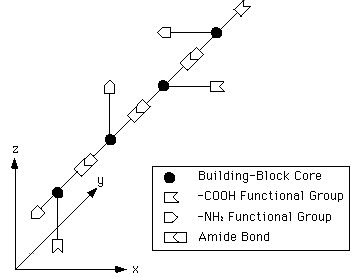(part of Steps Toward Molecular Manufacturing)
- rasters and lattices:
It appears to be feasible and reasonable
to specify 3D rasters, overall lattice structures, according to which
all constructional activities are to be outlined and oriented. The
need for rasterization arises out of the necessity to link MBBs with
as little strain as possible, in order to be able to form the links at
all, because chemistry needs precise alignment of the components. This
becomes very difficult if the individual parts do not fit into the
framework, so trying to "bridge the gaps" and attempting "final ring
closure" operations in strained systems would cause a lot of
headaches.
By exploiting symmetries in the MBBs and in
the construction process, it is possible to mutually cancel irregular
angles introduced by the particular chemistries of the links.
A very important question concerns the exact
number of links that have to be established to integrate a MBB into a
growing structure, and in what sequence these links should be made. The
first thing that comes to mind is that this number should be as low as
possible. The lower the number, the fewer are the necessary chemical
reactions and the higher is the yield of the final product (or maybe
rather: the higher is the chance of getting a functional product at
all, in the case of machinery). In addition, the difficulties of
steric hindrance are somewhat relaxed if fewer links have to be
established after the first one connects the newly added MBB with the
structure. Maybe one could call this phenomenon a reduction of
"link-density per volume" ?
In a very nice analysis of 3D-networks
[Wel77] it is argued in chapt.4, that
in order to form a regular 3D-lattice, a repeat-unit of this lattice
has to have six free links for hooking up with neighbors, arranged in
three pairs of diametrically opposed links, these link pairs being
parallel to three non-coplanar axes, respectively. Unfortunately, it
is very difficult to conceive of an organic molecule which would be
able to undergo six link-forming reactions. Such a MBB would have to
be an object with a cube-like geometry, and it is non-trivial to find
an appropriate skeleton structure that would provide the required
attachment geometries for the links.
But the argument in
[Wel77] runs a step further: the
repeat-units themselves can be built up from smaller parts, for
example by joining two MBBs capable of forming four links each
(leading to the diamond lattice in the case of tetrahedral
geometry). Most currently investigated molecular aggregates, named
"designer solids" in [Ama93], do
not yet seem to have employed these lattice building concepts in a
conscious design strategy. A good exception though can be found in
[See82].
One could even use MBBs with only three links,
and then four of them would be needed to construct a repeat-unit. This
possibility is illustrated symbolically in figure 1.

FIGURE 1: A repeat-unit in a 3D lattice, composed of four smaller MBBs. The
chemistry of the links indicated should just be taken symbolically.
A macromolecular structure would be assembled not
by adding these rather large and elongated, inconveniently shaped
repeat-units, but by adding the smaller constituent MBBs one at a
time. On the average, one thus would have to form 1.5 links per block
added, so one would alternate between forming one and two links per
block. In this way, one has to go into the trouble of making two links
at the same time only with half of all the MBBs used.
Here an important trade-off issue arises:
the obviously beneficial desire to use MBBs with as few links as
possible leads to more open and loose lattices which are less densely
interknitted (lower link-density per volume) which also very favorably
facilitates the access to individual bonds during construction. But
because of the lesser crowding one will have to make sure that MBBs at
the construction site, which are tied into the growing structure by so
far only one completed link, do not obtain too many degrees of
rotational freedom and twist away so that they still can be easily
aligned for subsequent reactions. One way of solving this problem is
to use link-chemistries which do not generate bonds that allow
torsional freedom.
Also, the looser structures tend to show
less mechanical rigidity, and the fairly large cavities in the
interior of such lattices will be filled with solvent molecules
instead of something that could contribute more to the stiffness of
the structure. So it would be desirable to fill the empty spaces with
some stuffing material which could increase the stiffness through
non-covalent, van der Waals-type (vdW) interactions. This could be
achieved by additional side chains that are attached to the MBBs and
that pack in a definable way (see the further discussion on the
CavityStuffer
program below).
Navigational convenience for "Steps Toward Molecular Manufacturing":
[Back to Start]
[Previous Page: Two Sub-Problems]
[Next Page: Functional Groups]
last updated Oct. 5 1996
e-mail: kr@n-a-n-o.com
[Back to kr's Home Page]